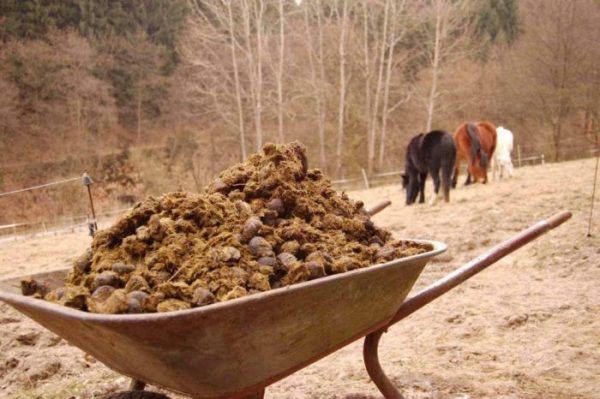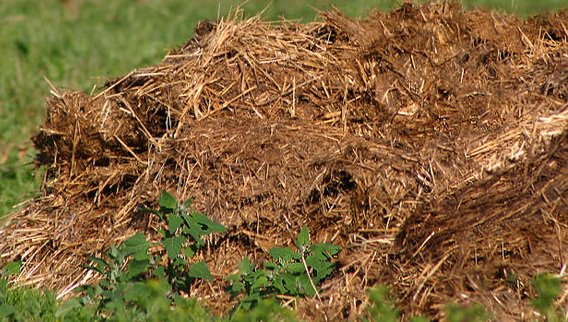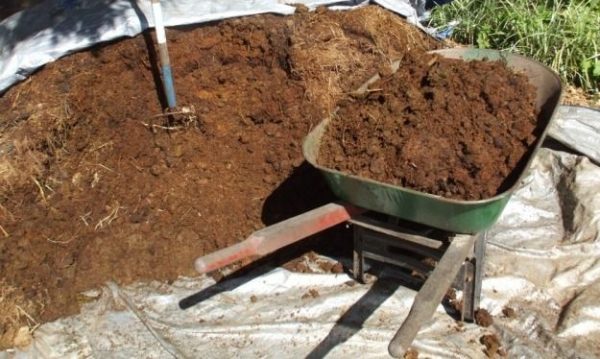Which manure is better: horse or cow?
Content
Which litter is better?
To figure out which litter is better, it is important to know its composition and the positive aspects that can be obtained when using organic fertilizer. Generally speaking, everything is useful for the garden: cow, horse, bird droppings (chicken) or rabbit droppings.
Depending on the technology of harvesting the droppings, you can:
- use for the purpose of obtaining compost;
- directly apply raw in the fall into the ground;
- apply as top dressing (liquid or dry) during the growing season of crops.
However, before using humus in agricultural technology, it is necessary to carry out special measures, the nature of which depends on the chemical and mechanical composition of manure (chicken). If we are talking about medium-sized thinness, then the chicken hen is considered to be the richest in terms of a set of nutrients. In addition, the rate of "ripening" of a fresh chicken is the highest, therefore, within a short period of time, plants treated with such fertilizer begin to receive additional nutrition. However, if it is necessary to fertilize large territories, then it is more profitable to use horse or mullein manure, since it is problematic to get a chicken in large volumes. The nutritional base of both types of organic fertilizer is about the same, but the time it takes to convert fresh horse manure into a useful top dressing is much less than for cow manure. It takes 9 to 12 months for horse excrement to decompose, while mullein takes 3 to 4 years.
It is impossible to say unequivocally which litter is better, since everything depends on the tasks that are planned to be implemented with his participation and the type of vegetable or horticultural crop. The only true judgment about such an organic fertilizer is that it takes time to obtain an excellent nutrient, so it is better to use fresh manure only in individual cases.
The use of horse manure in the beds
The use of horse manure is acceptable for most plants. Its composition is quite rich, therefore, as a catalyst, it has a very active effect on vegetation. Phosphorus and potassium, nitrogen and other trace elements - all this is in horse manure, the use of which increases productivity and plant resistance to various diseases. 1 kg of substrate contains:
- nitrogen - 4.7 g;
- calcium - 3.5 g;
- phosphorus - 3.8 g;
- potassium - 2g.
"Rich" top dressing is rare today, as it can be obtained only in large stables. However, thanks to the work of agrochemists, it is now possible to use horse manure in the beds in liquid form or in granules. One bag of fertilizer weighs up to 40 kg and contains 40-50 liters of dry manure. It is used on the beds in the following forms:
- Rotted manure.
- Fresh manure for heating beds in early spring.
- Liquid substance.
- In granules.
During the decomposition of the original organic material, a huge amount of heat is released, which is best used in beds with melons and gourds. The "burning" temperature is sufficient to grow watermelons, for example, in Siberia or the Urals. Overripe manure is also very useful for a large number of vegetable and horticultural crops, as it contains 2-3 times more nutrients than fresh material. On average, fruit trees require up to 5 buckets of substrate per unit to feed fruit trees, and 3 buckets for berry bushes.
The liquid substance, packaged in 5 liter plastic bottles, has also proven itself well as an organic type fertilizer. Such packaging is convenient if you have a small area. It is recommended to use it in the evening for watering or spraying a leaf outlet. Horse manure granulated is a compact package for those who want to work on a small area. It does not increase the toxicity of the soil, and most of the nutrients are retained in full. Preparing the top dressing takes some time:
- within 4 hours the dry granules are completely dissolved in water;
- before feeding, the composition is thoroughly mixed;
- watering rates according to the instructions on the package.
Video "How and what is better to feed the soil"
An informative video with useful information about organic and beneficial nutrition.
Using cow dung in the garden
The most common type of organic fertilizer is cow dung (mullein). Its use is available to almost everyone, since there is a lot of it and it is not as expensive as other types. In addition, the susceptibility of agricultural crops to cow dung is almost 100%. The composition of the substrate (per 1 kg) is as follows:
- nitrogen - 3.5 g;
- calcium - 2.9g;
- phosphorus -3 g;
- potassium -1.4 g
When preparing a fertilizer, it is important to know the sex and age of the animal, since the chemical set can be different. The excrement of adult cattle contains 15% more nutrients than young animals. The methods and volumes of application depend on the fertility of the soil, however, on average per 1 sq. m. 7-10 kg of manure is used. In liquid form, the substance may contain eggs of parasites, therefore it is recommended to use compost fertilizer or resort to fermentation of cow dung. When using a mullein to feed crops, you need to be extremely careful, as an excess amount of fertilizer can become a source of nitrates.
Interaction with different cultures
Vegetable crops are fertilized with horse waste in open and closed ground. When it comes to greenhouses and greenhouses, they are used as biofuels. When applying, a 30 cm layer of soil is removed, then manure is laid and irrigated with a weak solution of potassium permanganate for disinfection. After that, a layer of soil is laid, previously mixed with wood ash, back. Within 2 days, the site is not touched, and then you can sow seedlings or seeds. Which crops are more responsive to feeding:
- potatoes and pumpkin;
- cucumbers and zucchini;
- cabbage.
It is also recommended to fertilize the soil in autumn with fresh manure (5-6 kg of fertilizer per 1 sq. M.). Cow dung is best used in liquid form. A 1:10 ratio is called mullein. It is prepared from fresh material, while after mixing with water, the solution must be infused for seven days. This period is enough for some of the nitrogen to evaporate, and the nutrient base passes into a solution that can be used to feed all fruit and vegetable plants.
It is not recommended to use cow manure for the following crops:
- root crops, except for beets (the introduction of organic matter makes them hard and clumsy);
- legumes;
- radish, radish and cabbage;
- onion and garlic.
Procurement and storage
Harvesting and storage of organic fertilizer is possible both independently and it is provided for the purchase of finished material in packaged or liquid form. Fresh horse manure must be collected in a hole in the garden or a separate fence should be made on the site. When preparing, it is important to observe the sequence of laying the layers:
- Peat (20-30 cm).
- Manure (15cm).
- Sawdust, grass and foliage (30 cm).
- Earth (20 cm).
For fermentation in the winter, the pit must be covered with polyethylene. In the absence of individual materials, you can alternate layers of manure and peat, or manure and soil. In the summertime, the workpiece must be watered and “shaken” with a pitchfork several times. Composting cow dung-based compost requires the following conditions:
- Constant supply of oxygen and moisture. Air is essential for the life of bacteria, and moisture should prevent it from drying out. In dense stacks, it will be stored longer, and in a loose form, overheating occurs faster.
- Avoid freezing and rain. Rains can wash out all the nutrients, and frost can slow down the activity of microorganisms. It is not recommended to use the film, so as not to suffocate.
Thus, horse manure, mullein, chicken are excellent humus with an organic structure, the advantages of which are simply inexhaustible.
Video "Everything You Need to Know About Cow Feces"
Useful information about organic feeding.






